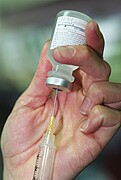
MONDAY, Jan. 7 (HealthDay News) — Although the news on the U.S. cancer front is generally good, experts report a troubling upswing in a few uncommon cancers linked to the sexually transmitted human papillomavirus (HPV).
Since 2000, certain cancers caused by HPV — anal cancer, cancer of the vulva, and some types of throat cancer — have been increasing, according to a new report issued by federal health agencies in collaboration with the American Cancer Society.
Overall, the report, published online Jan. 7 in the Journal of the National Cancer Institute, finds fewer Americans dying from common cancers such as colon, breast and prostate cancers than in years past.
And the HPV-linked cancers are still rare. But experts say more could be done to prevent them — including boosting vaccination rates among young people.
“We have a vaccine that’s safe and effective, and it’s being used too little,” said Dr. Mark Schiffman, a senior investigator at the U.S. National Cancer Institute.
More than 40 strains of HPV can be passed through sexual activity, and some of them can also promote cancer. The best known is cervical cancer.
HPV is also blamed for most cases of anal cancer, a large share of vaginal, vulvar and penile cancers, and some cases of throat cancer.
The new report found that between 2000 and 2009, rates of anal cancer inched up among white and black men and women, while vulvar cancer rose among white and black women. HPV-linked throat cancers increased among white adults, even as smoking-related throat cancer became less common.
The reasons are not clear, said Edgar Simard, a senior epidemiologist at the American Cancer Society who worked on the study.
“HPV is a sexually transmitted virus, so we can speculate that changes in sexual practices may be involved,” Simard said.
For example, prior studies have linked the rise in HPV-associated oral cancers to a rise in the popularity of oral sex. HPV can be transmitted via oral intercourse, and a study published in 2011 in the Journal of Clinical Oncology found that the percentage of oral cancers that are linked to HPV jumped from about 16 percent in the mid-1980s to 72 percent by 2004.
Not all HPV-linked cancers have increased, and the biggest exception is cervical cancer. That cancer is almost always caused by HPV, but rates have been falling in the United States for years, and the trend continued after 2000, Simard said.
That’s because doctors routinely catch and treat pre-cancerous abnormalities in the cervix by doing Pap tests and, in more recent years, tests for HPV.
In contrast, Schiffman noted, there are no routine screening tests for the HPV-related cancers now on the rise.
Those cancers do remain rare. Between 2005 and 2009, rates of anal cancer were 1.6 cases for every 100,000 U.S. men, and 2.5 per 100,000 women. Meanwhile, roughly 8 out of every 100,000 men were diagnosed with an HPV-linked throat cancer; the rate among women was under 2 per 100,000.
HPV infection, on the other hand, is common. Roughly half of sexually active Americans contract it at some point in their lives, according to the U.S. Centers for Disease Control and Prevention.
Most of those people will never develop an HPV-related cancer because the immune system usually clears the infection fairly quickly. But some people harbor chronic infections, which sometimes lead to cancer.
That’s why experts recommend that girls and boys ages 11 and 12 receive an HPV vaccine, which is given in three doses. Older girls and young women up to age 26 are advised to get “catch-up” shots if they were never vaccinated. The same advice goes for boys and men ages 13 to 21.
But the new report says most Americans are not following that advice. In 2010, 32 percent of girls ages 13 to 17 had received all three doses of the HPV vaccine, and far fewer got the full vaccine in southern states such as Mississippi and Alabama. (The report did not look at boys’ rates because experts only recently began recommending the vaccine for them.)
Schiffman said the girls’ vaccination rate can be improved. “We are behind some other countries,” he said.
In the United Kingdom and Australia, for instance, HPV vaccination rates among girls and women top 70 percent.
Simard said that getting more doctors to recommend the HPV vaccine to parents and young adults is vital.
Cost is another issue. The two HPV vaccines — Merck’s Gardasil and GlaxoSmithKline’s Cervarix — cost about $400 for three doses.
Low-income families can get the vaccine for free through the federal Vaccines for Children program. But Simard’s team found that girls who were eligible for the program but lacked any health insurance had low rates of HPV vaccination: Just 14 percent had gotten three doses.
Better access to overall health care might help close that gap, Simard said.
According to Schiffman, it’s not clear how effective HPV vaccination will ultimately be in preventing HPV-related cancers. But one strain — HPV 16 — is thought to cause the majority of cancers linked to the virus. And both HPV vaccines protect against that strain.
More information
Learn more about HPV and cancer from the U.S. National Cancer Institute.

